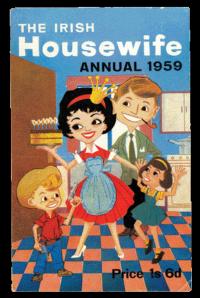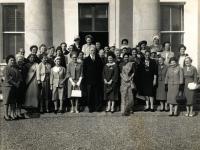Hilda Tweedy—the original desperate housewife?
Published in 20th Century Social Perspectives, 20th-century / Contemporary History, Book Reviews, General, Issue 6 (Nov/Dec 2011), News, Volume 19
Cover of the Irish Housewives’ Association magazine, The Irish Housewife, 1959, published from 1946 until 1967. (National Archives of Ireland)
Hilda Tweedy, founder of the Irish Housewives’ Association, was born in Clones, Co. Monaghan, in 1911. Recognising the importance of Tweedy’s work, Alan Hayes of Arlen House sought to honour her memory. Hayes’s vision has culminated in an exhibition and a book publication, which will be launched at a symposium celebrating Tweedy’s life and work on 26 November in the Long Room Hub, Trinity College, Dublin. This series brings together an impressive collaboration of forces, including Catriona Crowe of the National Archives, designer Ger Garland and Tweedy’s own family. The events are being hosted by the Centre for Gender and Women’s Studies, Trinity College, Dublin, in association with the Women’s History Association of Ireland. The exhibition, based on the Tweedy collection in the National Archives of Ireland, provides a detailed account of her work and documents the women’s movement in Ireland from the 1940s to the 1980s. Tweedy became politically active after a play, Marrowbone Lane, was revived at the Gate Theatre in 1941. The play exposed the shocking reality of Dublin tenement life. Neutral Ireland, then in a state of Emergency during World War II, experienced severe shortages of food and fuel. Moved to action, Tweedy wrote to numerous friends:
‘What is your dream of Ireland? What does the story of Marrowbone Lane mean to you? Are you satisfied that you are doing all in your power to build the kind of world you wish your children to live in?’
Along with four other women, Tweedy organised a petition calling for government rationing of all essential foods in order to control prices and to suppress the black market. It was sent before budget day on 5 May 1941 to the government, opposition parties and to the press, who dubbed it the ‘Housewives’ Petition’. Advised by trade unionist Louie Bennett to follow up on the demands of the petition, Tweedy, Andrée Sheehy Skeffington and Susan Manning formed a non-political, non-sectarian pressure group in 1942. To exploit the media attention the ‘housewives’ received, they adopted the name ‘the Irish Housewives’ Association’ (IHA), a somewhat misleading title for a rather radical organisation. The board of the IHA were young, educated married women who were mainly excluded from playing active roles in the public sphere. Initially the group lobbied for fair distribution of goods and services. Tweedy instigated an intense campaign, bombarding the minister for supplies, Seán Lemass, with letters regarding overcharging of goods, exporting of basic food items and suggestions for rationing. IHA members were encouraged to report any trader who did not offer appropriate service or goods at fair prices. This infuriated shopkeepers, leading one to complain to the Evening Mail on 20 January 1943 that ‘Mrs Tweedy and Mrs Skeffington should mind their own business’. Through IHA campaigns the government was pressured to introduce progressive food and hygiene regulations. The group also instigated the establishment of the Consumers’ Association of Ireland, a non-profit organisation that is still successfully protecting consumers’ rights today. The IHA soon extended its focus, including issues such as equal pay for women, the introduction of women police and the removal of the public service marriage bar. The association was not afraid to support controversial matters, taking to the streets in support of Dr Noel Browne’s doomed Mother and Child Scheme. After affiliating with the International Alliance of Women in 1947, the IHA adopted a global awareness. Following a United Nations directive in 1967, Tweedy successfully lobbied for a national commission to report on the status of women in Irish society. She became the first chair of the Council for the Status of Women, a precursor to the National Women’s Council of Ireland, which now has over 150 affiliated organisations.

President Eamon de Valera welcoming delegates of the International Alliance of Women Congress to Áras an Uachtaráin in 1961. Hilda Tweedy is standing on de Valera’s left. (National Archives of Ireland)
She was appointed to the boards of the Women’s Representative Committee and the Employment Equality Agency, and became president of the Irish United Nations Association. The exhibition presents a vivid account of Hilda Tweedy’s life and work up to her death at the age of 93 in 2005. The exhibition, book and symposium will be launched at the Long Room Hub, Trinity College, Dublin, on 26 November and the exhibition will tour Dublin’s libraries thereafter. HI
Sonja Tiernan is curator of the Hilda Tweedy exhibition. Her latest book, Eva Gore-Booth: an image of such politics, will be published by Manchester University Press in 2012.
Further reading:
A. Hayes (ed.), Hilda Tweedy: a link in the chain (Dublin, 2011).
















